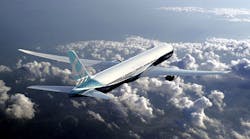WASHINGTON - Months before Malaysia Airlines flight MH370 mysteriously vanished, U.S. regulators warned of a "cracking and corrosion" problem on Boeing (IW 500/14) 777s that could lead to a mid-air breakup and drastic drop in cabin pressure.
The revelation comes amid a desperate search for traces of the plane with 239 people on board, which lost contact with air traffic control at around 17:30 GMT Friday, about an hour after take-off from Kuala Lumpur en route to Beijing.
"We are issuing this AD (Airworthiness Directive) to detect and correct cracking and corrosion in the fuselage skin, which could lead to rapid decompression and loss of structural integrity of the airplane," the Federal Aviation Administration said.
During a sudden drop in cabin pressure, the crew and passengers can become unconscious, leaving no one at the controls of the affected aircraft.
In 1999, a Learjet carrying golfer Payne Stewart crashed into a field in South Dakota after flying uncontrolled for several hours after those on board apparently became unconscious due to a lack of oxygen brought on by a loss of cabin pressure.
Malaysia's air force chief has raised the possibility that MH370 inexplicably turned back and was quoted as saying the jet had been tracked hundreds of miles from its intended flight path.
The FAA circulated a draft of the directive warning of the cracking and corrosion problem Sept. 26, 2013.
A final directive was issued March 5, three days before the Malaysia Airlines jet disappeared. The FAA directive is to take effect April 9.
The FAA said it was "prompted by a report of cracking in the fuselage skin underneath the satellite communication (SATCOM) antenna adapter."
"This AD requires repetitive inspections of the visible fuselage skin and doubler if installed, for cracking, corrosion, and any indication of contact of a certain fastener to a bonding jumper, and repair if necessary," it added.
The FAA said an estimated 120 U.S. registered aircraft are affected by the directive.
A supporting document accompanying the directive indicates that one unidentified operator reported a "16-inch crack" of the fuselage skin in an aircraft that was 14 years old.
Boeing performed a "metallurgical fracture analysis" of the affected section of the fuselage skin, according to the document.
As the hunt for the missing plane dragged into its fifth day, Malaysian authorities said they were expanding their search zone off Vietnam's South China Sea coast to the Andaman Sea north of Indonesia, hundreds of miles away.
Copyright Agence France-Presse, 2014



